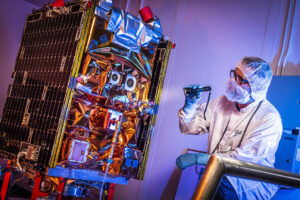Ball Aerospace wrapping up green propellant smallsat demo mission
By Caleb Henry

WASHINGTON — Ball Aerospace says it has successfully flight-tested a green propellant developed by the Air Force, and is lowering the satellite’s altitude so that it deorbits later this summer.
The Green Propellant Infusion Mission satellite proved that the new fuel, called AF-M315E, could be used to fly a satellite, Brain Marotta, GPIM attitude determination and control lead at Ball Aerospace, said during a prerecorded presentation for the SmallSat 2020 conference.
The Air Force Research Laboratory developed the green fuel, designed as a replacement for hydrazine. Marotta said AF-M315E is a higher performance fuel that is also nontoxic, meaning specialists loading the propellant onto a satellite don’t need the protective gear required for hydrazine, which is corrosive.
“GPIM has accomplished what it was designed to do,” Marotta said. “We flight qualified a brand-new domestic propulsion technology on a very capable and flexible spacecraft platform.”
Ball Aerospace built the satellite on its BCP-100 smallsat platform, with five thrusters from Aerojet Rocketdyne. The NASA-funded mission was expected to launch in 2016 on a SpaceX Falcon Heavy, but delays with that rocket’s introduction pushed the launch out to June 2019. GPIM sat in storage for three and a half years while waiting for Falcon Heavy, Marotta said.
GPIM launched into a 720-kilometer low Earth orbit, and then conducted three burns, each lasting six minutes, to lower its altitude to 575 kilometers. Marotta said Ball Aerospace chose that maneuver first so that GPIM would naturally deorbit within 25 years in the event of a malfunction.
Ball Aerospace conducted a series of propulsive tests in the 13 months since GPIM’s launch, including a simulated detumble test where its thrusters were able to stabilize the spacecraft, he said.
Subsequent maneuvers have lowered GPIM’s altitude to about 300 kilometers, Marotta said. In mid-August, Ball Aerospace will use the remainder of the satellite’s fuel to fly down to roughly 180 kilometers, where atmospheric drag should capture the satellite in two to four weeks, he said.
“The remaining flight operations will continue to provide valuable data on how this propulsion system performs as it ages,” he said.
GPIM carries two space weather payloads as secondary missions for the U.S. Defense Department: the Integrated Miniaturized ElectroStatic Analyzer – Reflight, and the Small Wind and Temperature Spectrometer. The satellite also hosts the Defense Department’s Space Object Selftracker, a space situational awareness experiment, and a new multi-layer insulation technology developed by Ball and Quest Thermal Group through a NASA Small Business Innovative Research grant.
GPIM launched as a 154-kilogram satellite, including 14.2 kilograms of propellant, Chris McLean, GPIM principal investigator at Ball Aerospace, told SpaceNews by email. He said the spacecraft has used up about 12 kilograms so far.
August 3, 2020 at 11:57PM
via SpaceNews read more...

Post a Comment